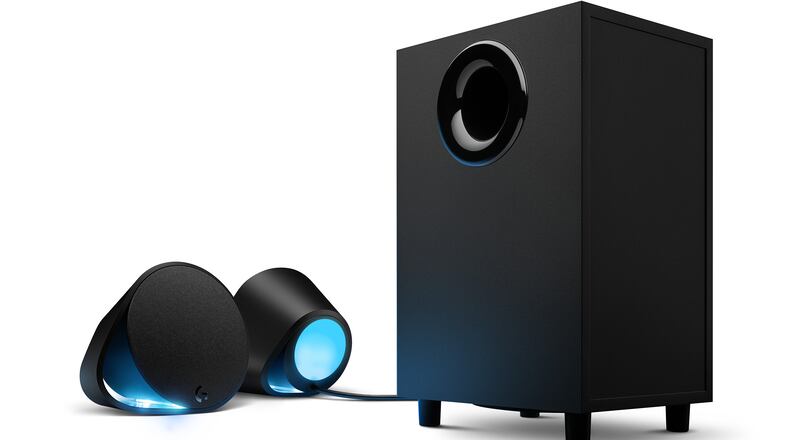In the era of esports, headsets have become the norm when it comes to audio hardware for PCs. Speakers and technology have shrunk and evolved enough that companies can simulate the effects of surround sound in a solid set of cans.
Meanwhile, PC speakers have gone in the opposite direction. They haven’t advanced much in the past decade, sticking to booming subwoofers and soundbars, but Logitech is changing that. The longtime peripheral maker is trying to revolutionize the category by thinking beyond sound with its latest product, the Logitech G560.
At first glance, it looks like a standard 2.1 setup. The system features a 240 watt subwoofer that rumbles alive when players start gaming. That’s backed by two satellite speakers for the left and right. Together, they create a great soundscape that reminds players of the magic that can’t be duplicated by headsets.
There’s a presence and deep thudding bass that headsets can’t match. The satellite speakers produce good sound for the size. They won’t make players go wow with their clarity or crispiness, and they won’t be confused with sound from a movie theater, but they do pack a punch. The satellite speakers are forceful when it matters thanks to the subwoofer, giving players loud blasts from gunfire or the burst of explosions from grenades.
The DTS:X Ultra support is solid, depending on whether your game supports it. Players get a good sense of where a sound source is coming from, but it’s not as distinct as hearing it from a great headset. The positional audio gives players a general sense that feels more atmospheric and ephemeral than exact.
That would have been good for a PC speakers of the past five years, but what nudges the G560 to the next level is the intelligent Lightsync technology that the company built into the satellites. They can be programmed to react to music or the color of game screen itself. Think of it as the Philip’s Light Hue smart bulbs but geared toward a gamers.
Lightsync extends the play space beyond the screen. They can reflect the action in games such as “Overwatch” or “Battlefield 1.” If players are in an area with a fire, the lights can glow red to match the flames and that deepens the immersion. If they’re in water, the lights change blue denoting the depths of the sea. With the Logitech Gaming Software, players can easily program the light settings for more practical purposes. For example, if the cooldown for a certain move is over, they can set it up so that the lights shine bright, letting players know that it’s available.
All this is done by using the Logitech Gaming Software and using the accompanying presets that developers offer or they can implement it themselves using a quick screen sampler program. In it, players designate areas of the screen that the lights will reflect. I used it to highlight the Turn Button on “Hearthstone,” so the lights would shine gold when it was my turn to play cards. I get distracted easily and knowing when to make my move was helpful.
In other games, it can conceivably give players an edge, but the G560 has other features going for it. Most notably, the speakers have an unbelievable amount of flexibility. Players can use them as standard PC speakers to watch YouTube videos or play music in the background. They can connect the speakers to a phone or tablet so that it plays music from the mobile devices. The lights can be adjusted so they become an audio visualizer along with accompanying Logitech keyboard and mouse. It’s a cool effect to see.
The light show can be entertaining for a dorm room party, but be warned, the G560 is tuned for PC gaming. They won’t work with consoles, so these won’t hook up and work seamlessly with a PlayStation 4. In addition, the set of speakers work best in the confined space of a desk. Move them outside of that — like say a 55 inch big-screen TV — and the speakers lose a lot of their special oomph.
Still, there’s a lot to like about the G560. Aside from hooking it up to a phone wirelessly, the speakers also have a input for a 3.5mm headset. So players can in plug whatever headset they want and play if they don’t want to bother roommates or others. The only feature I wish it had is an automatic shut-off, but that quirk can’t take away from a forward-thinking set of PC speakers that show there’s more to audio beyond headsets.
About the Author
Keep Reading
The Latest
Featured

